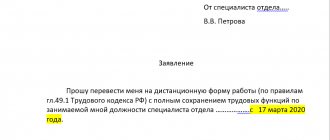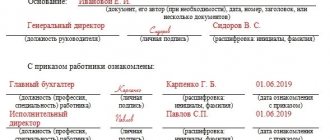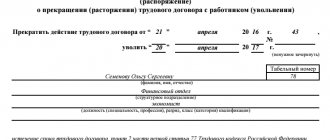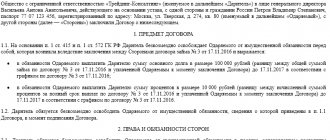Article 56. Concept of an employment contract. Parties to the employment contract
An employment contract is an agreement between an employer and an employee, according to which the employer undertakes to provide the employee with work for a specified labor function, to provide working conditions provided for by labor legislation and other regulatory legal acts containing labor law norms, a collective agreement, agreements, local regulations and by this agreement, to pay the employee wages in a timely manner and in full, and the employee undertakes to personally perform the labor function defined by this agreement and to comply with the internal labor regulations in force for this employer.
(Part one as amended by Federal Law No. 90-FZ dated June 30, 2006)
The parties to the employment contract are the employer and the employee.
The main reasons for drawing up additional agreements
An additional agreement can be drawn up for a variety of reasons:
- changes in wages, working hours, working conditions;
- transfer to another position;
- promotion, etc.
Also, an agreement must be drawn up in cases where the name of the organization has changed, its legal address has changed, or the current main employment contract has expired.
Thus, all changes that relate to the functions, rights, powers of the employee and the employer, as well as all changes related to the organization itself, must be recorded in an additional agreement to the employment contract.
Article 57. Contents of the employment contract
(as amended by Federal Law No. 90-FZ of June 30, 2006)
The employment contract specifies:
surname, name, patronymic of the employee and the name of the employer (surname, name, patronymic of the employer - an individual) who entered into an employment contract;
information about documents proving the identity of the employee and the employer - an individual;
taxpayer identification number (for employers, with the exception of employers - individuals who are not individual entrepreneurs);
information about the employer’s representative who signed the employment contract and the basis on which he is vested with the appropriate powers;
place and date of conclusion of the employment contract.
The following conditions are mandatory for inclusion in an employment contract:
place of work, and in the case when an employee is hired to work in a branch, representative office or other separate structural unit of the organization located in another area - place of work indicating the separate structural unit and its location;
labor function (work according to the position in accordance with the staffing table, profession, specialty indicating qualifications; specific type of work assigned to the employee). If, in accordance with this Code and other federal laws, the performance of work in certain positions, professions, specialties is associated with the provision of compensation and benefits or the presence of restrictions, then the names of these positions, professions or specialties and the qualification requirements for them must correspond to the names and requirements specified in qualification reference books approved in the manner established by the Government of the Russian Federation;
(as amended by Federal Law No. 13-FZ dated February 28, 2008)
the date of commencement of work, and in the case where a fixed-term employment contract is concluded, also the period of its validity and the circumstances (reasons) that served as the basis for concluding a fixed-term employment contract in accordance with this Code or other federal law;
terms of remuneration (including the size of the tariff rate or salary (official salary) of the employee, additional payments, allowances and incentive payments);
working hours and rest hours (if for a given employee it differs from the general rules in force for a given employer);
compensation for hard work and work under harmful and (or) dangerous working conditions, if the employee is hired under appropriate conditions, indicating the characteristics of working conditions in the workplace;
conditions that determine, in necessary cases, the nature of the work (mobile, traveling, on the road, other nature of work);
a condition on compulsory social insurance of the employee in accordance with this Code and other federal laws;
other conditions in cases provided for by labor legislation and other regulatory legal acts containing labor law norms.
If, when concluding an employment contract, it did not include any information and (or) conditions from those provided for in parts one and two of this article, then this is not a basis for recognizing the employment contract as not concluded or for its termination. The employment contract must be supplemented with missing information and (or) conditions. In this case, the missing information is entered directly into the text of the employment contract, and the missing conditions are determined by an annex to the employment contract or a separate agreement of the parties, concluded in writing, which are an integral part of the employment contract.
The employment contract may provide for additional conditions that do not worsen the employee’s position in comparison with established labor legislation and other regulatory legal acts containing labor law norms, collective agreements, agreements, local regulations, in particular:
on clarification of the place of work (indicating the structural unit and its location) and (or) the workplace;
about the test;
on non-disclosure of secrets protected by law (state, official, commercial and other);
on the employee’s obligation to work after training for no less than the period established by the contract, if the training was carried out at the expense of the employer;
on the types and conditions of additional employee insurance;
on improving the social and living conditions of the employee and his family members;
on clarification, in relation to the working conditions of a given employee, of the rights and obligations of the employee and the employer established by labor legislation and other regulatory legal acts containing labor law norms.
By agreement of the parties, the employment contract may also include the rights and obligations of the employee and employer established by labor legislation and other regulatory legal acts containing labor law norms, local regulations, as well as the rights and obligations of the employee and employer arising from the terms of the collective agreement and agreements . Failure to include any of the specified rights and (or) obligations of the employee and employer in the employment contract cannot be considered as a refusal to exercise these rights or fulfill these obligations.
Employment contract with internal part-time worker: download sample
It is optimal if the agreement contains:
- In the “General Provisions” section : wording that the work is performed on an internal part-time basis;
- a statement stating that there are no harmful or dangerous working conditions in the part-time workplace (indicating the date of the special assessment), if the main job is harmful or dangerous.
Article 58. Duration of the employment contract
Employment contracts can be concluded:
1) for an indefinite period;
2) for a certain period of not more than five years (fixed-term employment contract), unless a different period is established by this Code and other federal laws.
A fixed-term employment contract is concluded when the employment relationship cannot be established for an indefinite period, taking into account the nature of the work to be done or the conditions for its implementation, namely in the cases provided for in part one of Article 59 of this Code. In the cases provided for in part two of Article 59 of this Code, a fixed-term employment contract may be concluded by agreement of the parties to the employment contract without taking into account the nature of the work to be performed and the conditions for its implementation.
(Part two as amended by Federal Law No. 90-FZ of June 30, 2006)
If the employment contract does not specify the duration of its validity, the contract is considered to be concluded for an indefinite period.
In the event that neither party has requested termination of a fixed-term employment contract due to its expiration and the employee continues to work after the expiration of the employment contract, the condition on the fixed-term nature of the employment contract loses force and the employment contract is considered concluded for an indefinite period.
(Part four as amended by Federal Law No. 90-FZ of June 30, 2006)
An employment contract concluded for a specific period in the absence of sufficient grounds established by the court is considered concluded for an indefinite period.
(as amended by Federal Law No. 90-FZ of June 30, 2006)
It is prohibited to conclude fixed-term employment contracts in order to evade the provision of rights and guarantees provided for employees with whom an employment contract is concluded for an indefinite period.
(as amended by Federal Law No. 90-FZ of June 30, 2006)
How to draw up an employment contract
Only written form is acceptable. The document is drawn up in two copies, each of which is signed by both parties (Article of the Labor Code of the Russian Federation). One is given to the employee, and the second (kept by the employer) must bear the employee’s signature confirming that he received his copy. This is where the mandatory requirements for the procedure for drawing up an employment contract end. All other points are optional.
In particular, the legislation does not contain an obligation to number employment contracts. Therefore, if the employer does not consider it necessary, he may not assign them numbers.
But if the number of employees is significant, numbering is advisable, as it will help organize documents and ensure their quick identification. The employer has the right to independently develop a numbering system. Or you can use the method given in the letter of Rostrud dated 08/09/07 No. 3045-6-0: the contract number consists of its serial number and numbers indicating the month and (or) year of its conclusion.
REFERENCE
The law does not require an employment contract to be certified with the employer’s seal. This means that even if an organization has a seal, the absence of its imprint on an employment contract is not an error. Nor will it be a violation to certify the contract with the employer’s seal.
Article 59. Fixed-term employment contract
(as amended by Federal Law No. 90-FZ of June 30, 2006)
A fixed-term employment contract is concluded:
for the duration of the performance of the duties of an absent employee, whose place of work is retained in accordance with labor legislation and other regulatory legal acts containing labor law norms, a collective agreement, agreements, local regulations, and an employment contract;
for the duration of temporary (up to two months) work;
to perform seasonal work, when, due to natural conditions, work can only be carried out during a certain period (season);
with persons sent to work abroad;
for carrying out work that goes beyond the normal activities of the employer (reconstruction, installation, commissioning and other work), as well as work related to a deliberately temporary (up to one year) expansion of production or the volume of services provided;
with persons entering work in organizations created for a predetermined period or to perform a predetermined job;
with persons hired to perform obviously defined work in cases where its completion cannot be determined by a specific date;
to perform work directly related to the internship and professional training of the employee;
in cases of election for a certain period to an elected body or to an elective position for paid work, as well as employment related to the direct support of the activities of members of elected bodies or officials in state authorities and local self-government bodies, in political parties and other public associations;
with persons sent by employment services to temporary work and public works;
with citizens sent to perform alternative civil service;
in other cases provided for by this Code or other federal laws.
By agreement of the parties, a fixed-term employment contract may be concluded:
with persons entering work for employers - small businesses (including individual entrepreneurs), the number of employees of which does not exceed 35 people (in the field of retail trade and consumer services - 20 people);
with age pensioners entering work, as well as with persons who, for health reasons, in accordance with a medical certificate issued in the manner established by federal laws and other regulatory legal acts of the Russian Federation, are allowed to work exclusively of a temporary nature;
with persons entering work in organizations located in the Far North and equivalent areas, if this is related to moving to the place of work;
to carry out urgent work to prevent disasters, accidents, accidents, epidemics, epizootics, as well as to eliminate the consequences of these and other emergency circumstances;
with persons elected through a competition to fill the relevant position, conducted in the manner established by labor legislation and other regulatory legal acts containing labor law norms;
with creative workers of the media, cinematography organizations, theaters, theatrical and concert organizations, circuses and other persons involved in the creation and (or) performance (exhibition) of works, in accordance with the lists of works, professions, positions of these workers, approved by the Government of the Russian Federation Federation, taking into account the opinion of the Russian Tripartite Commission for the Regulation of Social and Labor Relations;
(as amended by Federal Law No. 13-FZ dated February 28, 2008)
with managers, deputy managers and chief accountants of organizations, regardless of their legal forms and forms of ownership;
with persons studying full-time;
with crew members of sea vessels, inland navigation vessels and mixed (river-sea) navigation vessels registered in the Russian International Register of Vessels;
(paragraph introduced by Federal Law dated November 7, 2011 N 305-FZ)
with persons applying for part-time work;
in other cases provided for by this Code or other federal laws.
Documents for drawing up an employment contract
Before concluding an employment contract, the employee must present the following set of documents (Part 1 of Article of the Labor Code of the Russian Federation):
- general passport;
- work book, if the applicant has previously worked. There are three exceptions. The first is that the employee switched to an electronic work book (see: “Electronic work books: what employers should do in 2021”). In this case, information about labor activity is provided in the form STD-R or STD-PFR (Part 3 of Article 66.1 of the Labor Code of the Russian Federation). The second is that a person is hired part-time. In this case, a work book (information) is not required at all (Article 283 of the Labor Code of the Russian Federation). And the third situation is that the employee lost or damaged the previously issued work book, but did not switch to the electronic version (Part 5 of Article of the Labor Code of the Russian Federation). In this case, it is recommended to take a corresponding application from him;
Prepare all documents for the transition to electronic work books
- document on registration in the individual (personalized) accounting system. Such a document can be either a SNILS card (issued before 04/01/2019), or a notification of registration in this system in the form of an electronic document or on paper (Resolution of the Pension Fund Board dated 06/13/19 No. 335p; see: “The form of the document that replaced SNILS plastic card"). An exception is made for persons who have not previously worked and are not registered in the Pension Fund system. The employer must register them after concluding an employment contract;
- military registration documents (provided by those liable for military service and persons subject to conscription for military service);
Prepare personnel reports for the military registration and enlistment office and other regulatory authorities
- document on education, qualifications or special knowledge (provided upon applying for a job that requires special knowledge or special training).
Sometimes additional documents may be required. For example, if an employee is hired for a position to which persons who have or have had a criminal record or have been subject to criminal prosecution cannot be admitted. In this case, a certificate of absence of criminal record or the fact of criminal prosecution (termination of such on rehabilitative grounds) is required.
Article 61. Entry into force of an employment contract
An employment contract comes into force from the day it is signed by the employee and the employer, unless otherwise established by federal laws, other regulatory legal acts of the Russian Federation or the employment contract, or from the day the employee is actually admitted to work with the knowledge or on behalf of the employer or his representative.
(as amended by Federal Law No. 90-FZ of June 30, 2006)
The employee is obliged to begin performing his job duties on the date specified in the employment contract.
If the employment contract does not specify the start date of work, the employee must begin work on the next working day after the contract enters into force.
(as amended by Federal Law No. 90-FZ of June 30, 2006)
If the employee does not start work on the start day of work established in accordance with part two or three of this article, then the employer has the right to cancel the employment contract. A canceled employment contract is considered unconcluded. Cancellation of an employment contract does not deprive the employee of the right to receive benefits for compulsory social insurance in the event of an insured event during the period from the date of conclusion of the employment contract until the day of its cancellation.
(Part four as amended by Federal Law No. 90-FZ of June 30, 2006)
Civil legal relations formalized in an agreement
If the work performed or services provided do not require consistency, but are one-time in nature, the payer is interested in a specific result within a certain period of time, and not a constant work process, then it makes sense not to draw up an employment contract with the provision of vacations and sick leave to the employee, but to draw up a civil law contract .
- Piece wages in an employment contract
For comparison, as an example: it is more profitable to formalize the services of a nanny or housekeeper with an employment agreement, since the time of arrival and departure and the validity of the reason in case of absence are important. It is more profitable to formalize the services of a team for carrying out repairs through a contract related to civil law agreements, since the specific time of the work process does not matter, the result and the deadline for receipt are of paramount importance.
If the total transaction amount exceeds 10,000 rubles, a civil contract between individuals must be drawn up “on paper” based on the requirements of Article 161 of the Civil Code of the Russian Federation.
The following are required to be reflected:
- description of the service provided or work performed, including deadlines;
- price and calculation procedure, reimbursement of expenses incurred in the event of force majeure circumstances;
- responsibility of the parties, the procedure for satisfying claims regarding quality, failure to meet deadlines for the provision of services and calculations, the mechanism for calculating penalties and financial sanctions in case of dissatisfaction of participants;
- procedure for early termination of relations and coverage of losses.
Representatives of the parties can be both individuals with the status of individual entrepreneurs and citizens without the appropriate status. But if services are provided on a paid basis systematically, a citizen who is not registered as a business entity faces an administrative fine in the amount of 2,000 rubles in accordance with Article 14.1 of the Code of Administrative Offenses of the Russian Federation.
Sample of a standard employment contract with an employee 2021 and the procedure for filling it out
The full form of a standard employer-employee agreement includes many different situations and wording. But the organization has an excellent opportunity to leave in the form only the information that is necessary to work with a specific employee. Anything unnecessary can be simply removed. This standard employment contract is unique in that officials have included correct wording in it that complies with the norms of the Labor Code of the Russian Federation for all possible situations. It even has sections that cover remote and home workers. The only thing that is not provided for by this document is the employment of foreign citizens. In fact, legislators have placed many types of employment contracts in one form.
For example, let's look at how a micro-enterprise can draw up employment contracts in 2021: a sample will show an agreement with the manager of the sales department. The step-by-step instructions that we ended up with look like this:
Step 1. The “General Provisions” section is required to be completed in all cases. It should indicate the full name of the employer and its address, last name, first name, patronymic and position of the future employee.
In addition, if necessary, the test period established for the new specialist and the nature of his work: main or part-time, are also indicated here. In the same chapter, you should indicate the period for which the employment contract was concluded, if it is fixed-term. This information is additional and must be filled in if necessary. It is also necessary to indicate at what point the employee begins work, and note where his workplace is located, or note the traveling nature of the work. For example, in our case, a sales manager travels around the city to conclude sales transactions with clients. If the work does not have any special features, you can indicate that “the employee does not have a special nature of the work.”
When hiring a home worker, you will need to fill out clauses 9.1 or 9.2 in the “General Provisions” section. They provide a list of equipment that such an employee uses, and the procedure and timing for providing him with the necessary materials for work (if he needs them). You can provide for the payment of compensation for the use of personal property for business purposes and indicate its amount and terms of payment. In the case of remote employees, it is very important to indicate the length of work and rest time.
Expert opinion
Novikov Oleg Tarasovich
Legal consultant with 7 years of experience. Specializes in criminal law. Member of the Bar Association.
Step 2. The section “Employee Rights and Responsibilities” specifies what job functions the new specialist performs. Typically, this part of the form remains with the standard terms, but the employer may indicate specifics at the end of each subsection.
Step 3. Section “Rights and obligations of the employer.” Similarly, with the second section, you can leave all the points proposed by officials, and also, if necessary, add your own. For example, indicate what tools and equipment the employee is provided with.
Step 4. Section “Employee remuneration”. This is a very important part of the document and special attention must be paid to it if the organization has refused to accept the wage provision. Here it is necessary to specify in detail what the salary consists of. A standard employment contract provides for several types of payments, next to each of which you must indicate the amount:
- official salary;
- compensation payments (for work in hazardous conditions, use of personal transport, etc.);
- incentive payments (bonuses and incentives);
- other payments.
In addition to the amount, you must indicate the conditions for receipt and frequency. The employment contract also specifies specific terms for payment of wages and methods for receiving them.
Step 5. Section “Working time and rest time of the employee.” Here you indicate the length of the working day, rest time, weekends and vacations. Only fill in the lines that are necessary.
Step 6. Section “Occupational Safety and Health”. Here you should indicate the working conditions established for the employee, and note the mandatory and frequency of medical examination. If an employee is required to wear personal protective equipment, indicate which ones.
Step 7. Section “Social insurance and other guarantees.” The section is filled out when paying an employee for training, a voluntary health insurance policy, compensation for the cost of rental housing, vouchers to sanatoriums and other social guarantees.
Step 8. The section “Other terms of the employment contract” is very short. Most often, its completion is required when employing homeworkers or when concluding an agreement with an individual entrepreneur. Here the grounds for terminating the relationship between employee and employer are prescribed, different from those provided for by the Labor Code of the Russian Federation.
This is important to know: Fixed-term contract with an employee: mandatory conditions, sample 2021
Step 9. The section “Changing the terms of an employment contract” usually contains general information that the terms can only be changed by agreement of the parties. Most often, nothing needs to be changed or added to it.
Step 10. The section “Responsibility of the parties to the employment contract” contains standard conditions suitable for most cases.
Step 11. Section 11 “Final Provisions”. Here the employee signs all the rules and regulations with which he is familiar. These include a collective agreement (if there is one), job responsibilities, initial briefing on labor protection and civil defense, various instructions and routines. At the end, the full details of the employer and employee must be indicated and the signatures of both parties to the contract must be indicated. The employee must sign that he has read the entire text of the contract and has received its second copy.
We talked about how to conclude an employment contract with an employee: the 2021 sample shows all the stages of working on the document step by step. A unified employment contract (form) will optimize the work of the HR department not only in micro-enterprises, but also in other organizations. The main thing is to monitor all changes in legislation in a timely manner and make the necessary adjustments to the document as needed when hiring new employees. A sample employment contract with an employee 2021 can help with your work (variants of contracts with different specialists were prepared by PPT experts).
The essence of the additional agreement
If an employment contract has the nature of a basic document and establishes the fact of labor relations between an employee of an enterprise and his employer, their period, conditions, features and other parameters, then an additional agreement is an attached document.
Usually additional the agreement certifies the fact that agreement has been reached between the employee and the employer on only one or two amended clauses of the main agreement, completely canceling their previous version and introducing a new one.
Once the agreement is signed, as stated above, it is considered part of the contract. It must be said that several additional agreements can be made to one employment contract.








